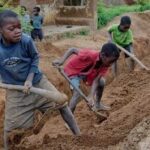The Sustainable Development Goal (SDG) 8.7 seeks to mobilise global commitment to ending all forms of child labour by 2025. With statistics showing that about 160 million children are still in child labour and 79 million in hazardous work, there is much to do to achieve the goal. To achieve the target, global leaders said economies must commit to the Durban Declaration, where ending child labour must be a central goal of economic and social policies, GLORIA NWAFOR reports.
With the adoption of the United Nations (UN) Resolution 72/327 in 2017, the year 2021 was declared the “International Year for the Elimination of Child Labour” by UN member States; thereby renewing their commitment to accelerating actions to eliminate child labour.
The impact of the actions to accelerate child labour elimination in 2021, The Guardian learnt would help to fast-track progress towards achieving the SDG 8.7 target to eliminate child labour by 2025.
This, it further learnt, would create momentum that would drive positive change through to 2025.
Article 32 of the Convention on the Rights of the Child, ILO Convention 182 on the Elimination of the Worst Forms of Child Labour and ILO Convention 138 on the Minimum Age of Employment recognise the right of every child to be protected from economic exploitation and from performing any work that is likely to interfere with the child’s education or harm the child’s health.
One year remaining to the target, the Director-General of ILO Gilbert Houngbo, during the commemoration of this year’s World Day Against Child Labour, marked every June 12, said that currently, 160 million children are in child labour, while out of the number, 79 million are in hazardous work.
He recalled the Durban Declaration, two years ago, where global leaders agreed that ending child labour must be a central goal of economic and social policies.
Speaking on this year’s theme ‘Let Us Act on our Commitments: End Child Labour’, the ILO chief said economies must ensure there is a universal action on the commitment.
According to him, as long as there are millions of children whose basic right to education and health is unfulfilled, social justice will remain elusive.
On what this means for Africa and Nigeria, specifically, a recent report on Nigeria Child Labour Survey 2022, released by the National Bureau of Statistics (NBS) in collaboration with the ILO and the Federal Ministry of Labour and Employment of Nigeria in the Nigeria Child Labour and Forced Labour Survey (NCFLS) 2022, examined the patterns of child employment, the conditions of the employment and the key household characteristics that may contribute to child employment and child labour.
It stated that 39.2 per cent of Nigerian children aged five to 17 years are still prevalent in child labour.
It said the prevalence of hazardous labour in children aged five to 17 years was 22.9 per cent, or 14,390,353.
Of the children in child labour, the NBS said 24.2 per cent were in employment and worked in the agricultural sector.
The bureau stated that during the period, 50.5 per cent within the same age range were involved in economic activity.
The percentage which hovered around 31,756,302 children in economic activity has about 50.7 per cent boys and 50.2 per cent girls, while 41.8 per cent are from urban and 51.7 per cent are from rural areas.
The report also stated that more than 62.9 million children five to 17 years old live in Nigeria, representing 30.3 per cent of the population.
The NCFLS data was collected from a nationally representative sample of 16,418 households.
The survey shows that more children live in rural areas than urban areas: 62.4 per cent (39,252,721) reside in rural areas compared to 37.6 per cent (23,647,758) in urban areas.
The current survey allowed for the classification of children 5 to 17 years old into four mutually exclusive categories: children who are exclusively working, children who are exclusively in school, children who are working and in school and children who neither work nor go to school.
The survey indicates that among the 5–14 age group, 42.3 per cent are full-time students who are not engaged in any form of economic activity, 35.3 per cent are in school and working simultaneously, and 11.2 per cent are working only.
Among the 15–17 age group, a larger proportion of children are working only, at 21.9 per cent of the population of that age. Furthermore, only 24.7 per cent are exclusively in school and 45.3 per cent are working and in school.
The Guardian gathered that child labour reinforces intergenerational poverty, threatens national economies and undercuts rights guaranteed by the Convention on the Rights of the Child.
It is the combined product of many factors, such as poverty, social norms condoning it, lack of decent work opportunities for adults and adolescents, migration, and emergencies.
It is not only a cause but also a consequence of social inequities reinforced by discrimination.
According to labour experts, effective action against child labour must address the full range of vulnerabilities that children face and requires the implementation of policies and programmes that can contribute to the elimination of child labour through sustainable solutions to address its root causes.
Immediate past President of the Human Capital Providers Association of Nigeria (HuCaPAN), Aderemi Adegboyega, said with the body’s code of conduct, it does not engage workers below the age of 18 years.
He submitted that the government is trying its best to reduce the incidence of child labour, but cited the poverty level in the country, as one of the factors for an increase in child labour.
He argued that some parents are the ones forcing their children into labour by directly asking them to work on their farms, or asking them to fend for themselves, describing it as “unfair”, as it delays the child’s mental development.
With these, he opined that labour legislation be seriously enforced to make sure that such incidences are reduced to the barest minimum, noting that this can only work when the inspection arm of the labour ministry is up to the task.
“On-street trading and begging, the government can on its own enforce that kids shouldn’t engage in street trading. The regulatory agencies should go to where these goods originate and tell the manufacturers that they don’t want to see them on the streets. You cannot arrest the people selling it only.
“Also, there should be domestic employment standards for apprentices and domestic staff,” he said.
Similarly, the Director-General, of Nigeria Employers’ Consultative Association (NECA), Adewale-Smatt Oyerinde, stressed that child labour remained a pressing issue in Nigeria, affecting millions of children who are denied their basic rights to education, health and a safe environment.
He said the day serves as a poignant reminder of the urgent need to implement and strengthen policies aimed at eradicating child labour in workplaces, particularly within business value chains and promoting overall child welfare.
Reflecting on this year’s theme, Oyerinde emphasised the need for concrete actions and collaboration to fulfill pledges.
“As stakeholders, we must reflect on our progress on this important issue and identify areas where we can intensify our efforts,” he said.
He said NECA has been pivotal in the fight against the worst forms of child labour, having developed a ‘Code of Conduct and Guidance Tool for businesses within the Organised Private Sector’.
He said the tool aims to guide companies toward the elimination of child labour in Nigeria.
According to him, the association has advocated for increased allocation of corporate social responsibility resources towards initiatives aimed at eliminating child labour.
The NECA boss urged the government at both national and sub-national levels to prioritise the welfare of children in their development agendas by ensuring that policies and programmes are effectively implemented and adequately funded for maximum impact.
The NECA chief also commended the ILO for working with the association and private sector employers for their various Corporate Social Responsibilities (CSR), even in a challenging economic environment, towards the eradication of child labour in Nigeria.
He reiterated NECA’s and employers’ commitment to upholding and enforcing policies that prohibit child labour in all forms across supply chains and operations.
He also affirmed the private sector’s willingness to continue to invest in educational programmes and skill development initiatives that offer children and their families alternatives to child labour.
The United Nations Children’s Fund (UNICEF) on the commemoration of this year’s Child Labour Day said that child labour could result in extreme bodily and mental harm and even death.
It said it could also lead to slavery and sexual or economic exploitation. And in nearly every case, it cuts children off from schooling and health care, restricting their fundamental rights.
Similarly, the United Nations said this year’s World Day focused on celebrating the 25th anniversary of the adoption of the Worst Forms of Child Labour Convention (1999, No. 182).
It said it also presented an opportunity to remind all stakeholders to improve their implementation of the two fundamental Conventions on child labour – Convention No. 182 and Convention No. 138 concerning the Minimum Age for Admission to Employment or Work (1973).
Although, it said significant strides have been taken in reducing child labour over time, recent years have seen global trends reverse, underscoring the pressing need to unite efforts in expediting actions to eradicate child labour in all its manifestations.
With the adoption of Sustainable Development Goal Target 8.7, the international community committed to the elimination of child labour in all its forms by 2025.
It said this year’s commemoration called for the effective implementation of the ILO Convention No. 182 on the Worst Forms of Child Labour; and reinvigorated national, regional and international action to end child labour in all of its forms, including worst forms, through adopting national policies and addressing root causes as called upon in the 2022 Durban Call to Action.
It added that the u ratification and effective implementation of ILO Convention No. 138 on the Minimum Age, which, together with the universal ratification of ILO Convention No. 182 on the Worst Forms of Child Labour achieved in 2020, would provide all children with legal protection against all forms of child labour.












